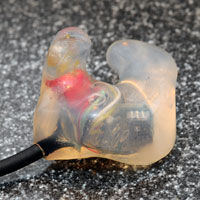Miniature system enhances safety data collection
JUN 29, 2012
There’s a lot of technology packed into the accelerometers that are slipped into the ears of IZOD IndyCar Series and Firestone Indy Lights drivers before all on-track activity.
Accelerometers, encased in molded earpieces, measure and record vertical, lateral and longitudinal G forces of high-impact events. A G is a unit of measurement that determines the pull of gravity on the body under acceleration, and a driver’s body will pull about three times the force of gravity (3 Gs) in the turns of high-banked ovals and tight corners such as the Exhibition Place street circuit for the Honda Indy Toronto on June 6-8.
But it has been the bulkiness of the earpieces – not seating in the ear canal of some drivers since being mandated by INDYCAR in 2005 – that started INDYCAR director of engineering Jeff Horton on a crusade.
 “We package the accelerometer with the speaker for radio communication and the only thing available in the industry was a single axis chip, so it takes three of them to measure X, Y and Z,” Horton said. “Even as miniature as they are, they are quite big to fit in drivers’ ears. For many years, we’ve been looking for a smaller alternative.”
“We package the accelerometer with the speaker for radio communication and the only thing available in the industry was a single axis chip, so it takes three of them to measure X, Y and Z,” Horton said. “Even as miniature as they are, they are quite big to fit in drivers’ ears. For many years, we’ve been looking for a smaller alternative.”
Analog Devices Inc., a Massachusetts-based leader in high-performance semiconductors for signal processing applications, recently came up with the solution by packaging all three axis onto a single 3 mm x 3 mm x 1.45 mm chip, which is about the size of a single chip in the previous system. It’s named the ADXL377, and INDYCAR drivers are the first to benefit from the technology.
“In the event of a collision, the sensor instantly and accurately captures (analog) data,” said Mark Martin, vice president and general manager, MEMS and Sensors Technology group, Analog Devices. “Moving from three individual accelerometers to one 3-axis MEMS accelerometer simplified our design by eliminating the need for placement and alignment of three orthogonal sensors.”
The ear accelerometers complement the accident data recorder, which measures G forces on the chassis, to design sled testing of helmets, shoulder harnesses, paddings, etc., utilizing INDYCAR’s THOR (Test Device for Human Occupant Restraint) crash test dummy.
Many of the safety enhancements of the new Dallara car were developed through downloaded data from both systems, and testing continues to accentuate driver safety.
“Moving from three individual accelerometers to one three-axis accelerometer simplified our design by eliminating the need for placement and alignment of three orthogonal sensors,” INDYCAR vice president of technology Will Phillips said.
The miniaturized accelerometers potentially have research applications in other sports such as football, hockey and boxing -- which have been scrutinized for their high incidence of concussions -- the U.S. Armed Forces, the automotive industry and NASA. INDYCAR has a long-standing data exchange program with NASA, whose next generation of manned space flights will include a return to water landings.
Horton’s next goal is to include a fourth element to one side of the ear accelerometers – a rotational device chip.
“Concussions, which fortunately we don’t suffer much anymore, have a big rotational component,” he said, “so it’s not just the hard hit but the twisting of the brain. Anything we can do to help study what our drivers are going through would help. “When we look at the future at INDYCAR, we’re basically trying to put ourselves out of business. If we can design a race car in which nobody gets hurt, we’re happy to do it.”
















